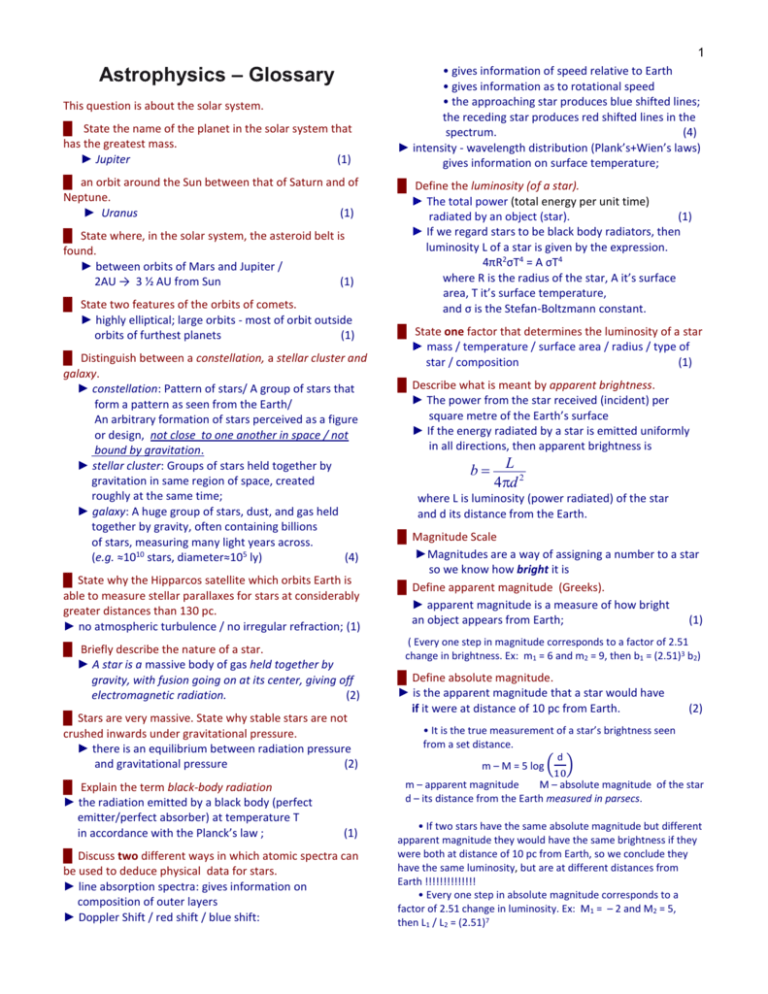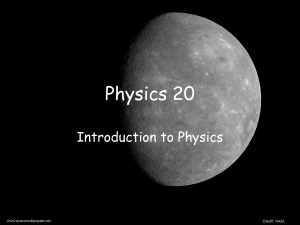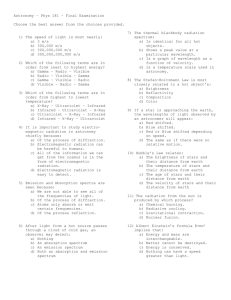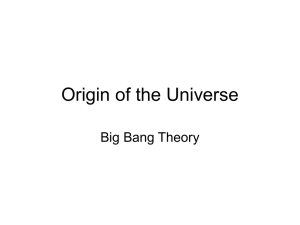click - Uplift Education
advertisement

Astrophysics – Glossary This question is about the solar system. █ State the name of the planet in the solar system that has the greatest mass. ► Jupiter (1) █ an orbit around the Sun between that of Saturn and of Neptune. ► Uranus (1) █ State where, in the solar system, the asteroid belt is found. ► between orbits of Mars and Jupiter / 2AU → 3 ½ AU from Sun (1) █ State two features of the orbits of comets. ► highly elliptical; large orbits - most of orbit outside orbits of furthest planets (1) █ Distinguish between a constellation, a stellar cluster and galaxy. ► constellation: Pattern of stars/ A group of stars that form a pattern as seen from the Earth/ An arbitrary formation of stars perceived as a figure or design, not close to one another in space / not bound by gravitation. ► stellar cluster: Groups of stars held together by gravitation in same region of space, created roughly at the same time; ► galaxy: A huge group of stars, dust, and gas held together by gravity, often containing billions of stars, measuring many light years across. (e.g. ≈1010 stars, diameter≈105 ly) (4) █ State why the Hipparcos satellite which orbits Earth is able to measure stellar parallaxes for stars at considerably greater distances than 130 pc. ► no atmospheric turbulence / no irregular refraction; (1) █ Briefly describe the nature of a star. ► A star is a massive body of gas held together by gravity, with fusion going on at its center, giving off electromagnetic radiation. (2) █ Stars are very massive. State why stable stars are not crushed inwards under gravitational pressure. ► there is an equilibrium between radiation pressure and gravitational pressure (2) █ Explain the term black-body radiation ► the radiation emitted by a black body (perfect emitter/perfect absorber) at temperature T in accordance with the Planck’s law ; 1 • gives information of speed relative to Earth • gives information as to rotational speed • the approaching star produces blue shifted lines; the receding star produces red shifted lines in the spectrum. (4) ► intensity - wavelength distribution (Plank’s+Wien’s laws) gives information on surface temperature; █ Define the luminosity (of a star). ► The total power (total energy per unit time) radiated by an object (star). (1) ► If we regard stars to be black body radiators, then luminosity L of a star is given by the expression. 4πR2σT4 = A σT4 where R is the radius of the star, A it’s surface area, T it’s surface temperature, and σ is the Stefan-Boltzmann constant. █ State one factor that determines the luminosity of a star ► mass / temperature / surface area / radius / type of star / composition (1) █ Describe what is meant by apparent brightness. ► The power from the star received (incident) per square metre of the Earth’s surface ► If the energy radiated by a star is emitted uniformly in all directions, then apparent brightness is b L 4d 2 where L is luminosity (power radiated) of the star and d its distance from the Earth. █ Magnitude Scale ►Magnitudes are a way of assigning a number to a star so we know how bright it is █ Define apparent magnitude (Greeks). ► apparent magnitude is a measure of how bright an object appears from Earth; (1) ( Every one step in magnitude corresponds to a factor of 2.51 change in brightness. Ex: m1 = 6 and m2 = 9, then b1 = (2.51)3 b2) █ Define absolute magnitude. ► is the apparent magnitude that a star would have if it were at distance of 10 pc from Earth. (2) • It is the true measurement of a star’s brightness seen from a set distance. d m – M = 5 log ( ) 10 m – apparent magnitude M – absolute magnitude of the star d – its distance from the Earth measured in parsecs. (1) █ Discuss two different ways in which atomic spectra can be used to deduce physical data for stars. ► line absorption spectra: gives information on composition of outer layers ► Doppler Shift / red shift / blue shift: • If two stars have the same absolute magnitude but different apparent magnitude they would have the same brightness if they were both at distance of 10 pc from Earth, so we conclude they have the same luminosity, but are at different distances from Earth !!!!!!!!!!!!!! • Every one step in absolute magnitude corresponds to a factor of 2.51 change in luminosity. Ex: M1 = – 2 and M2 = 5, then L1 / L2 = (2.51)7 █ The diagram shows the (intensity) spectrum of the radiation emitted by a black-body at a temperature T. Sketch the spectrum of radiation emitted by the black body at a higher/lower T. ► higher temperature : lower T: peak higher; peak lower; peak sharper; peak blunter; peak to left; peak to right; (2) (In this graph it is assumed that intensity is actually power/unit surface of the star. Otherwise it might be confusing, because bigger star at lower temperature can have greater luminosity, so the graph may be above the graph of the star with smaller surface area but higher temperature.) (higher T: shorter wavelengths, higher frequencies; higher energy. The curve should be above the existing curve at all locations ) (lower T: longer wavelengths, lower frequencies, lower energy. The curve should be below the existing curve at all locations ) █ Label the x-axis of the graph ► wavelength λ (1) █ Define a binary star ► A binary star is a stellar system consisting of two stars orbiting around their common center of mass. (1) (Binary stars can either be distinguished optically (visual binaries) or by indirect techniques, such as spectroscopy.) █ State what can be deduced from knowing the period of the binary and the separation of the stars. ► the total mass of the binary system (1) █ What property, other than separation of the stars, of a visual binary system is measured in order to find the mass of the system? ► the orbital period of the two stars (1) █ State the difference between a visual binary star, a spectroscopic binary star and eclipsing binaries ► visual binary: a system of stars that can be seen as two separate stars with a telescope and sometimes with the unaided eye. ► spectroscopic binary: A binary-star system which from Earth appears as a single star, but whose light spectrum (spectral lines) shows back-and-forth Doppler shifts as two stars orbit one another. ► eclipsing binary: (Rare) binary-star system in which the two stars are too close to be seen separately but is aligned in such a way that from Earth we periodically observe changes in brightness as each star successively passes in front of the other, that is, eclipses the other. (3) 2 █ Explain the importance of Cepheid variables for estimating distances to galaxies. ► There is a relationship between period and luminosity for Cepheid variables (discovered by Henrietta Swan Leavitt nearly a century ago), so measuring the period gives the luminosity and hence the distance (b = L/4πd2). Distances to galaxies are then known if the Cepheid can be ascertained to be within a specific galaxy; (3) █ Cepheids are sometimes referred to as standard candles. Explain what is meant by this. ► the phrase standard candle means having a source of light with known luminosity; ► measuring the period of a Cepheid allows its luminosity to be estimated; other stars in the same galaxy can be compared to this known luminosity (2) (approximately the same distance) █ Describe the characteristic by which a Cepheid variable may be identified from Earth. ► light output varies periodically; rapid brightening, gradual dimming; (2) █ Outline the cause of this characteristic. ► Caused by expansion / contraction of surface; brighter as it expands; (2) █ State the mechanism for the variation in the luminosity of the Cepheid variable. ► outer surface expands and contracts periodically due to interactions of matter and radiation in the stellar atmosphere; (brighter as it expands); ► changing surface temperature (2) █ Techniques for determining stellar distances include the use of stellar parallax, spectroscopic parallax and Cepheid variables. Outline all three: ► stellar parallax: two apparent positions of the star as seen by an observer from two widely separated points are compared and recorded; the maximum angular variation from the mean, p, is recorded; the distance (in parsecs) can be calculated using geometry d pc 1 p sec spectroscopic parallax: • light from star analyzed (relative amplitudes of the absorption spectrum lines) to give indication of stellar class • HR diagram used to estimate the luminosity • distance away calculated from apparent brightness Cepheid variables: • these stars’ brightness vary over time 3 • the time period of the variation is related to their luminosity •thus measurements of the time period of one star can be used to calculate its luminosity • its distance away is calculated from maximum apparent brightness █ A sketch of a Hertzsprung-Russell diagram is shown below. On the diagram, identify the (i) main sequence (label this M), (ii) red giant region (label this R), (iii) white dwarf region (label this W). █ In a Hertzsprung-Russell diagram, luminosity is plotted against temperature. Explain why the diagram alone does not enable the luminosity of a particular star to be determined from its temperature. ► luminosity depends on the surface temperature and the surface area (L = A σT4 ); A particular luminosity can not be determined from the graph without knowing the surface area, but the graph does not include area. (3) █ State two characteristics of a white dwarf that are different to the characteristics of a main sequence star. ► has smaller radius; ► more dense; ► higher surface temperature; ► energy not produced by nuclear fusion (2) Stars may be described in terms of their spectral classes. ► (2) Shematic H-R Diagram Class O B A Colour bluish blue white white Class F G K M Colour yellowish white yellowish orange red █ Describe the colour of a B star. ► blue (1) █ Identify the class of the Sun. ►G (1) Oh Boy, An F Grade Kills Me Oh Be, A Fine Guy Kiss Me COSMOLOGY this is surface temperature Calculation shows that the helium produced by nuclear fusion within stars cannot account for the real amount of helium in Universe (24%). In 1960 it was proposed that sometime during the early history of the Universe it was at a sufficiently high temperature to produce helium by fusion. In this process many high energy photons would be produced. The CMB (Cosmic Microwave Background Radiation) radiation was emitted only a few hundred thousand years after the Big Bang, long before stars or galaxies ever existed. The photons would have a black body spectrum corresponding to the then temperature of the Universe. As the Universe expanded and cooled the photon spectrum would also change with their maximum wavelength shifting in accordance with Wien’s law. It is estimated that at the present time the photons should have a maximum wavelength corresponding to a black body spectrum of an extremely cold object of temperature of 3 K. █ State what is meant by cosmological background radiation. ► Microwave radiation roughly the same in/from all directions; Radiation has characteristics of black body radiation at 2.7K (2) or cosmic background radiation is microwave radiation - left over from the Big Bang that fills the universe roughly uniformly in all directions. That radiation corresponds to a black body spectrum of about 2.7 K. █ Explain how cosmic background radiation is evidence in support of the Big Bang model of the universe. ► the Big Bang predicts an expanding universe that had a very high temperature at the beginning; during the expansion the universe is cooling down and the temperature of the radiation should fall to its present low value of about 2.7 K. or Big Bang producing initially very short wavelength photons/EM radiation; as the universe expands, the wavelengths become red shifted / longer (to reach current value); (2) █ Explain how knowledge of the spectrum of a black body and the existence of cosmological background radiation is consistent with the “Big Bang” model of the universe. ► Big Bang predicts a low temperature radiation at 2.7 K (i.e. CMB radiation). The Big Bang theory also predicts an expanded universe which we observe through redshifting of the galaxies and the lowering of CMB radiation temperature. This expanding universe is the result of the initial energy released in the Big Bang (3) 4 (2) galaxies are moving away from each other; █ A student makes the statement that .as a result of the Big Bang, the universe is expanding into a vacuum. Discuss whether the student’s statement is correct. ► the student is wrong; ► space is created as the universe expands / there is no outside to the universe; (2) This question is about Olbers’ paradox. Newton proposed a model of the universe that is infinite in extent and in which the stars are uniformly distributed. Olbers suggested that, if this model were correct, then the sky would never be dark. Explain how Olbers reached this conclusion. █ Newton made three assumptions about the nature of the universe. One of these assumptions is that the universe is static. State the other two assumptions. ► universe is infinite in extent; ► contains an infinite number of stars uniformly distributed, ► is static and exists forever. (2) █ Explain, using a quantitative argument, how these assumptions led to Olber’s paradox ► since stars are uniformly distributed the number of stars seen from Earth increases as d2 n – density of stars, t – thickness of the shell at distance d from Earth; number of stars in shell = density x volume = n 4πd2 t • brightness of one star decreases as 1/d2 ; b = L/4 πd2 █ State one other piece of evidence in support of the Big Bang model. ► the red shift in the light observed from distant galaxies (indicating that they are moving away from each other) ► the helium abundance in the universe which is about 25 % and is consistent with a hot beginning of the universe; (1) █ State one piece of evidence that indicates that the Universe is expanding. ► light from distant galaxies/stars is red-shifted (which means they move away from us – as the red-shifting occurs in all direction, the universe must be expanding) ► existence of CMB ► interstellar gas temperature in distant galaxies is 3K (1) █ Describe one piece of evidence that suggests that the universe is not static. ► light from distant galaxies is red-shifted from the Doppler effect this suggests the universe is expanding / • brightness of shell is constant; assuming that luminosity L is the same for all stars, the received energy per sec per unit area from all stars in the thin shell is: L 4d 2 nt Lnt const. 4d 2 • amount of light we receive from shell does not depend upon how far away the shell is • adding all shells to infinity; each contributing a constant amount of energy • sky would be uniformly bright; (the total energy received must be infinite) (4,5) The current Universe is ~ 13.7 billion years old and has an observable size of ~ 45 billion light years. This is much less than needed to produce Olbers's Paradox. Universe is not infinitely old, so light from distant stars would not yet have reached us. The fact that the Universe 5 has a finite age together with reduced light energy from the red shift in the expansion of the universe provides a solution to Olbers’ paradox. █ The critical density ρ0 of matter in the universe is given by the expression █ How is Olbers’ paradox resolved in the Big Bang model of the universe? ► there is a finite time since the Big Bang. Hence if you go back far enough in time (if you look far enough out in distance), eventually there will be no stars • The universe is not unchanging in time, it is expanding. Hence the most distant stars/ galaxies are strongly redshifted, out of the visible part of the spectrum. • Light from distant stars may not have reached us yet. where H0 is the Hubble constant and G is the gravitational constant. An estimate of H0 is 2.7x10-18 s-1. Calculate a value for ρ0. █ Suggest two reasons how the Big Bang model of the universe accounts for the night sky being dark. ► the Big Bang model leads to the idea of the expansion of the universe; ► the Big Bang model leads to the idea that the observable universe is not infinite; (2) The eventual fate of the Universe is determined by the amount of mass in the Universe. • The Universe could be closed. This means that the density of the Universe is such that gravity will stop the universe expanding and then cause it to contract. Eventually the contraction will result in a ‘Big Crunch’ after which the whole creation process could start again. • The Universe could be open. This means that the density is such that gravity is too weak to stop the Universe expanding forever. • Another possible development of the Universe is that it could be flat. This means that the density is at a critical value whereby the Universe will only start to contract after an infinite amount of time. The rate at which the Universe is expanding depends on the density of the Universe. █ Define critical density. ► the critical density is the density of the Universe which produces a flat universe, i.e. it would take an infinite amount of time to stop expansion of it. ► the critical density is the density of the Universe that would be necessary to stop the expansion after an infinite amount of time; (1) █ Recent measurements suggest that the mass density of the universe is likely to be less than the critical density. State what this observation implies for the evolution of the universe in the context of the Big Bang model. ► it implies that the universe will expand forever (open universe); 0 3H 02 8G ► substitution gives ρ0 = 1.3x10-26 kg m-3 (1) █ Hence determine the equivalent number of nucleons per unit volume at this critical density. 26 ► number density = 1.3 10 about 7 or 8 m 3 1.66 1027 WOW, not like you and me (1) █ Explain the significance of the critical density of matter in the universe with respect to the possible fate of the universe. █ Explain the importance of comparing the density of the Universe to the critical density in predicting the future of the Universe. ► whether the universe will expand forever or close back in on itself is determined by the comparison of these values ► at low density, the universe will continue to expand forever; ► at high densities, the universe will stop expanding and then contract / eventually contract; ► if the density of the universe equals critical density, the universe will expand forever at a slowing rate, taking infinite amount of time to stop expansion. (3) █ Outline what is meant by dark matter. ► matter that makes up for most of the mass in the universe, but cannot easily be detected because it does not emit radiation / light; (2) (It is believed that dark matter makes up a majority of the matter in our universe. It may be that this matter brings the density of the universe significantly close to the critical density.) █ Give two possible examples of dark matter. ► two of Neutrinos / WIMPS / MACHOS / black holes / exotic super symmetric particles / grand unified predicted particles / magnetic monopoles etc.; (two of these) or maybe our current theory of gravity is again not correct █ The diagram below shows one suggestion for the variation with time of the size of the 6 universe. This suggestion is referred to as the “flat” universe. On the diagram, draw a line to represent an “open” universe (3) non-coincident starts (not at beginning); correct shapes and correctly labelled; coincident at appropriate place;









